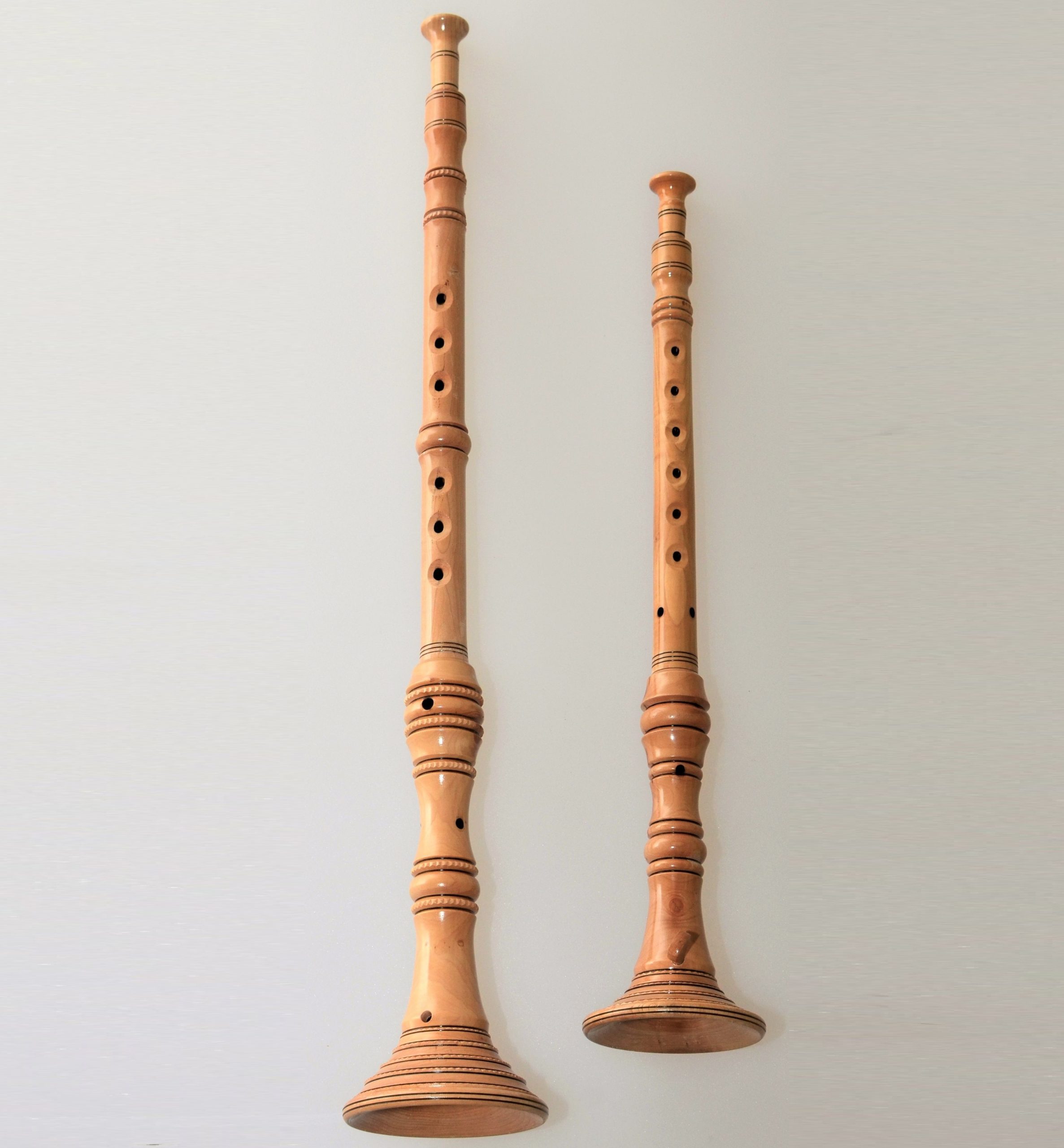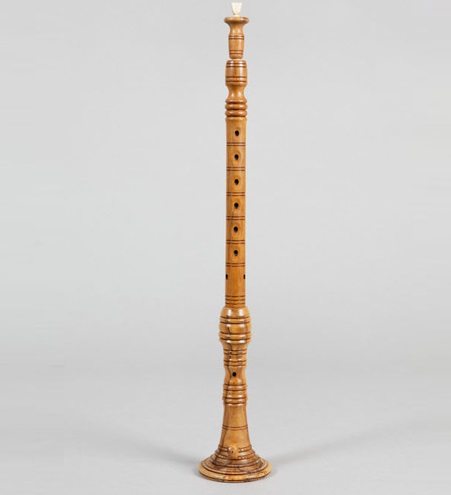Sopila
Woodwinds
Europe
Between 1001 and 1900 AD
Video
The sopila is a traditional woodwind instrument from the Balkan region, particularly associated with Croatia, especially the Istrian and Dalmatian coastal areas. It belongs to the double-reed aerophone family and is similar to the oboe. The sopila is primarily used in folk and ceremonial music, and its piercing, expressive sound makes it an essential part of regional musical traditions.
The instrument is played in pairs, with one sopila tuned slightly lower (termed “big sopila“) and the other higher (termed “small sopila”). This combination allows for a characteristic parallel melody style, where the two instruments play in a distinctive harmonic manner. The sopila is classified as a woodwind instrument, specifically a double-reed aerophone. It shares similarities with other traditional oboes found across Europe and Asia, such as the shawm and the zurna. The double-reed system gives it a distinctively powerful and nasal sound, making it suitable for outdoor performances and large gatherings.
History
The sopila has a long history in the Balkan Peninsula, particularly along the Adriatic coast in Croatia. It dates back to the Middle Ages, possibly as early as the 12th or 13th century. While its precise origins are uncertain, its close resemblance to ancient double-reed instruments suggests a historical link to earlier Mediterranean and Middle Eastern instruments.
Throughout the centuries, the sopila has been deeply embedded in the musical traditions of coastal communities in Istria, Dalmatia, and the Kvarner region. It was traditionally played during weddings, religious ceremonies, and village celebrations, reflecting its deep integration into local customs. The instrument has survived modernization largely due to dedicated musicians who continue to pass down its playing techniques and construction methods through oral tradition.
Types of Sopila
The sopila comes in two main types:
Big Sopila (Velika sopila) – This is the lower-pitched instrument, typically playing the harmonic foundation of the melody. It has a slightly larger size and a deeper tone.
Small Sopila (Mala sopila) – This is the higher-pitched instrument, which plays the main melody. It is slightly shorter and produces a sharper, more penetrating sound.
These two instruments are almost always played together, with the combination creating the unique harmonies characteristic of sopila music. The relationship between the big and small sopila is essential for the traditional Istrian scale, a unique modal system found in Croatian folk music.
Sopilas are traditionally handcrafted from wood, with the most common choices being olive wood, maple, or walnut. These woods are selected for their durability and acoustic properties, allowing the instrument to produce a resonant and sharp tone. The instrument consists of a cylindrical or slightly conical tube with several finger holes and a double reed, usually made from cane.
The reeds are delicate and require careful crafting to produce the correct vibration and timbre. Artisans who make sopilas often follow traditional techniques passed down through generations, ensuring the instrument retains its authentic sound.
Characteristics
The sopila has several distinct characteristics that set it apart from other woodwind instruments:
Loud, piercing sound – Due to its double-reed construction, the sopila can produce a powerful sound capable of cutting through noisy environments.
Nasal tone quality – Its timbre is often described as sharp, bright, and slightly reedy, similar to that of a shawm.
Parallel playing style – The instrument is almost always played in pairs, with one sopila complementing the other in a characteristic interval.
Ornamentation and embellishments – Traditional sopila playing involves rapid trills, grace notes, and other embellishments that add to the expressiveness of the music.
Cylindrical or slightly conical bore – The instrument’s shape contributes to its tone and allows for dynamic control.
Sound Production
The sopila produces sound through a double reed, which vibrates when air is blown through it. The player controls the pitch by covering and uncovering the finger holes on the instrument’s body. The intensity of the blowing, along with subtle changes in embouchure (lip pressure and mouth position), affects the dynamics and tonal quality.
Since the sopila does not have a standardized tuning, each pair is often custom-made to match a specific tuning system. The unique intervals between the big and small sopila give the instrument its distinct harmonized sound.
Playing Methods
Playing the sopila requires a high degree of skill, as the instrument’s reed demands precise control over breath pressure. The following are some key aspects of sopila performance:
Circular breathing – Advanced players often use circular breathing, a technique where they inhale through the nose while simultaneously pushing air into the instrument using their cheeks. This allows for uninterrupted, continuous playing.
Dynamic articulation – Players use tonguing techniques to create rhythmic accents and phrasing.
Finger dexterity – The rapid movement between finger holes, along with the use of half-holing for microtonal adjustments, contributes to the instrument’s expressive style.
Melodic and harmonic interplay – The two sopilas must be played in perfect coordination, requiring strong communication between musicians.
Roles in Music
The sopila plays a crucial role in traditional Croatian folk music, particularly in the following settings:
Folk dances – The sopila provides the main melodic and rhythmic accompaniment for traditional dances like the balun and tanac.
Ceremonial music – It is commonly played at weddings, religious processions, and other community gatherings.
Festival performances – Various Croatian cultural festivals feature sopila music as part of their celebrations.
Ensemble playing – Although primarily played in pairs, the sopila is sometimes accompanied by percussion or other folk instruments like the tamburica.
Cultural Significance
The sopila is more than just a musical instrument; it is an emblem of Croatian cultural heritage. Its music is closely linked to communal traditions, and its preservation is considered an essential part of maintaining local identity.
Several initiatives have been undertaken to safeguard the tradition of sopila playing, including:
Inclusion in UNESCO’s Intangible Cultural Heritage – Croatian folk music traditions, including sopila playing, have gained international recognition.
Music education programs – Efforts to teach younger generations have helped ensure the survival of the instrument.
Festival showcases – Events such as the Dalmatian Klapa Festival and regional folk music gatherings highlight the importance of the sopila in Croatian musical culture.
The sopila’s distinctive sound and historical importance continue to make it a cherished instrument, deeply embedded in the musical identity of Croatia.
FAQ
What is a Sopila?
The Sopila is a traditional Croatian woodwind instrument, similar to an oboe. It is commonly played in pairs, producing rich harmonies. The instrument is prominent in the folk music of Istria and Kvarner regions. Made from wood, it has a distinctive nasal tone.
How is the Sopila played?
The Sopila is typically played in pairs—one producing a melody and the other a drone or counterpoint. Players use circular breathing for continuous sound. Fingering techniques and embouchure control influence tone quality. The music is often fast-paced with intricate ornamentation.
What materials are used to make a Sopila?
Sopilas are crafted from hardwoods like maple or cherry, ensuring durability and rich sound. The reed is made from cane, similar to an oboe. The instrument is hand-carved with a conical bore for resonance. Each Sopila is unique, shaped by traditional craftsmanship.
 Links
Links
References
- Center for Russian & East European Studies: The Traditional Ukrainian Instrument - Sopilka
- Saint Sophia Cathedral: A Historical Site Featuring Ancient Musical Instruments
- Wikipedia: Saint Sophia Cathedral - A Place Where Ancient Music Was Depicted
- Google Arts & Culture: Exploring Traditional Instruments Like the Croatian Soplile
- The Metropolitan Museum of Art: Eastern European (Croatian) Musical Instruments Including Similar Types
Other Instrument
Categories



















